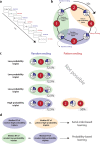Speed and accuracy instructions affect two aspects of skill learning differently
- PMID: 36273000
- PMCID: PMC9588023
- DOI: 10.1038/s41539-022-00144-9
Speed and accuracy instructions affect two aspects of skill learning differently
Abstract
Procedural learning is key to optimal skill learning and is essential for functioning in everyday life. The findings of previous studies are contradictory regarding whether procedural learning can be modified by prioritizing speed or accuracy during learning. The conflicting results may be due to the fact that procedural learning is a multifaceted cognitive function. The purpose of our study is to determine whether and how speed and accuracy instructions affect two aspects of procedural learning: the learning of probability-based and serial-order-based regularities. Two groups of healthy individuals were instructed to practice on a cued probabilistic sequence learning task: one group focused on being fast and the other on being accurate during the learning phase. The speed instruction resulted in enhanced expression of probability-based but not serial-order-based knowledge. After a retention period, we instructed the participants to focus on speed and accuracy equally, and we tested their acquired knowledge. The acquired knowledge was comparable between groups in both types of learning. These findings suggest that different aspects of procedural learning can be affected differently by instructions. However, only momentary performance might be boosted by speed instruction; the acquired knowledge remains intact. In addition, as the accuracy instruction resulted in accuracy near ceiling level, the results illustrate that response errors are not needed for humans to learn in the procedural domain and draw attention to the fact that different instructions can separate competence from performance.
© 2022. The Author(s).
Conflict of interest statement
The authors declare no competing interests.
Figures





Similar articles
-
Speed or Accuracy Instructions During Skill Learning do not Affect the Acquired Knowledge.Cereb Cortex Commun. 2020 Aug 10;1(1):tgaa041. doi: 10.1093/texcom/tgaa041. eCollection 2020. Cereb Cortex Commun. 2020. PMID: 34296110 Free PMC article.
-
Training Motor Sequences: Effects of Speed and Accuracy Instructions.J Mot Behav. 2019;51(5):540-550. doi: 10.1080/00222895.2018.1528202. Epub 2018 Nov 5. J Mot Behav. 2019. PMID: 30395789 Clinical Trial.
-
Is there more room to improve? The lifespan trajectory of procedural learning and its relationship to the between- and within-group differences in average response times.PLoS One. 2019 Jul 17;14(7):e0215116. doi: 10.1371/journal.pone.0215116. eCollection 2019. PLoS One. 2019. PMID: 31314804 Free PMC article.
-
The effects of timing of exposure to principles and procedural instruction specificity on learning an electrical troubleshooting skill.J Exp Psychol Appl. 2015 Dec;21(4):383-94. doi: 10.1037/xap0000065. Epub 2015 Oct 26. J Exp Psychol Appl. 2015. PMID: 26501503 Clinical Trial.
-
Basics for sensorimotor information processing: some implications for learning.Front Psychol. 2015 Feb 16;6:33. doi: 10.3389/fpsyg.2015.00033. eCollection 2015. Front Psychol. 2015. PMID: 25762944 Free PMC article. Review.
Cited by
-
Interbrain neural correlates of self and other integration in joint statistical learning.NPJ Sci Learn. 2024 Nov 20;9(1):68. doi: 10.1038/s41539-024-00280-4. NPJ Sci Learn. 2024. PMID: 39567522 Free PMC article.
References
-
- Romano Bergstrom JC, Howard JH, Howard DV. Enhanced implicit sequence learning in college-age video game players and musicians. Appl. Cogn. Psychol. 2012;26:91–96. doi: 10.1002/acp.1800. - DOI
LinkOut - more resources
Full Text Sources

